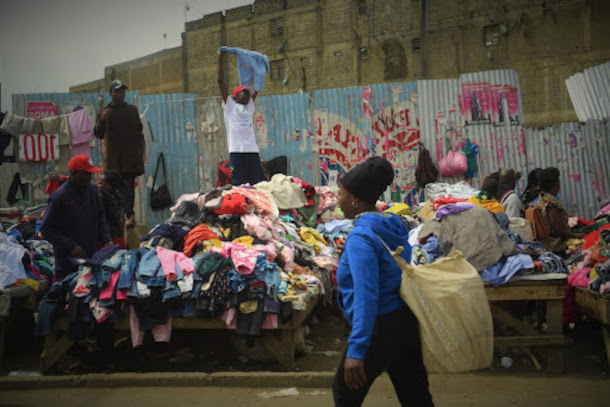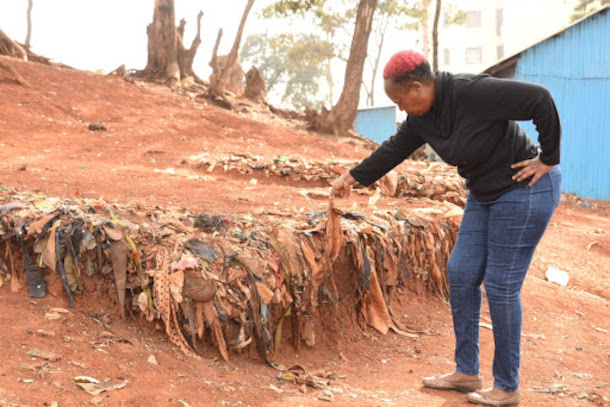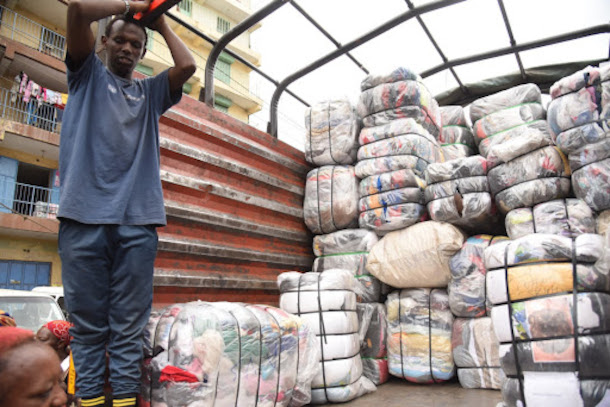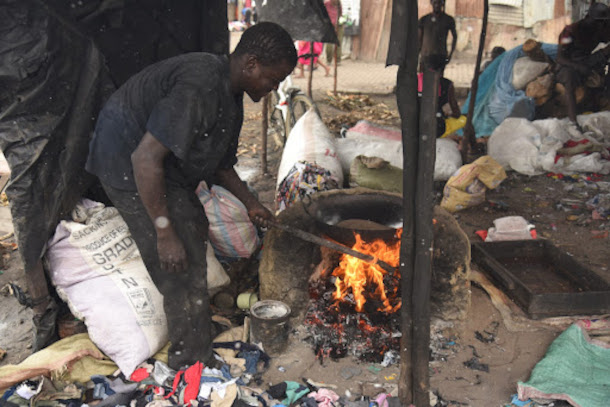Used Clothes Pollute Global South
Air Date: Week of April 14, 2023

Market traders at Gikomba Market in Nairobi sell their wares. The second-hand clothing market directly employs roughly two million people in Kenya. (Photo: Courtesy of Changing Markets Foundation and Clean Up Kenya)
In wealthy countries, cheap “fast fashion” clothing is often thrown away after being worn just seven or eight times. And while donating those clothes may feel like a good deed, they often end up as waste that pollutes developing countries. Veena Holkar, director of Wildlight Global, spoke with Living on Earth’s Bobby Bascomb.
Transcript
DOERING: It’s Living on Earth I’m Jenni Doering
O’NEILL: And I’m Aynsley O’Neill.
With warmer weather on the way and fashion brands unveiling their summer designs, it might be tempting to buy cheap, trendy clothes off the rack. But while they may be kind to your wallet, these “fast fashion” items are far from easy on the Earth. One study found that the average person bought 60% more clothes in 2014 than they did in 2000, but kept each item for half as long. And researchers find some low-cost clothing is thrown away after being worn just seven or eight times. Rather than throw clothes in the trash many people will donate unwanted items to thrift stores and that’s when the problem begins for many countries in the global south that receive the donated clothing. That’s according to a recent study commissioned by the Changing Markets Foundation. For more we called up Veena Holkar director of Wildlight Global. She conducted field work in Kenya for the report and spoke with Living on Earth’s Bobby Bascomb.
BASCOMB: So your investigation marched through what happens to used clothing, looking at Kenya as a destination. Why Kenya?
HOLKAR: We made a shortlist and we ended up going to Kenya because there's open access customs data for Kenya, which means that we could actually examine the data and see the names of companies that were shipping used clothing into Kenya and we could see the names of the companies that were receiving it. It's by no means the case that all used clothing is going to Kenya; it's going all over the world. Kenya is one place that we can actually have a close up look and see what's happening on the ground.
BASCOMB: So let's say you have a t-shirt that you don't want anymore, maybe your child has outgrown it. You take it to your local thrift store. What happens to that shirt that it somehow makes its way to Kenya, or one of the many, many other countries that take our used clothing?

Textile waste embedded into the soil surrounding a dumpsite in Kawangware. Unlike natural fibers like cotton or linen, synthetic fibers do not decompose. (Photo: Courtesy of Changing Markets Foundation and Clean Up Kenya)
HOLKAR: You take your t-shirt to the thrift store. If it's good enough quality to be resold, they'll put it out on the shop floor and it will get resold. If it's not quite good enough quality for that, they'll take it round the back and put it in a bag to be sorted. It will then be picked up by a recycling company, a commercial recycling company who will pay for it. And they'll sort through that clothing and they may then sell some of that. The stuff which they think isn't quite good enough will then be shipped abroad. Now it will go to a number of different countries predominantly in the Global South.
BASCOMB: And so what happens to that t-shirt once it arrives in Kenya?
HOLKAR: The ships arrive in Mombasa port, the large bales taken out and put in warehouses, and then they're sold on to middlemen. And eventually they make their way to the large undercover markets in the centers of the big cities. The one that we visited was in Nairobi, that's the biggest one of all. And at that point, the clothes in the bales are bought by secondhand market traders. The second hand market trader won't have any idea that t-shirt is even sitting inside of the bale they've just bought because they're not allowed to look at the contents of the bale before they buy it. They have to hand over their dollars and they will buy sight unseen around about 200 items of clothing. They'll cut the bale open, and that's the point where they discover whether or not they have got a decent amount of clothes in there that they can resell, or whether a large proportion of that clothing is going to be waste that they're going to be losing money on. And some of the traders that we spoke to do end up losing money, substantial amounts of money on some of the bales. It's basically a lottery. So let's assume that they've cut open the bale and they found your t-shirt in there. They'll have a look at it and they will try and assess whether or not they can recoup some of the purchase money on it. If it's in bad condition, by which I mean–and I saw plenty of t-shirts like this–stained or torn, covered in dog hair, covered in mud, completely misshapen and stretched, or perhaps a tiny little crop top t-shirt, which is completely inappropriate for Kenyan people, if it's that kind of t-shirt, then they will put it to one side. And at the end of the day, there will be a fagia trader who will come to the store and buy all of these items which were unsellable which were all in this pile at the back of the store, and they'll buy them for a very small amount of money. They will then take them away and see if they can sell them for point naught five of a cent even, miniature, tiny amounts of money. The likelihood is that they won't be able to sell it. They may then burn that clothing, they may throw it into the ground next to their store, which becomes a compacted mass of used clothing that's been discarded there. They may throw it into the river; we saw rivers completely choked with used clothing that had been discarded there. The problem in Kenya– and it's not specific to Kenya–is that the sort of infrastructure for disposing of refuse and waste is completely overburdened by the amount of waste that we're shipping over there. They can't cope with it, their waste systems can't cope with it.

Clothing bales being loaded onto a truck at Gikomba. Second-hand clothing traders are not allowed to look inside the bales until after they have purchased them. (Photo: Courtesy of Changing Markets Foundation and Clean Up Kenya)
BASCOMB: So much of our clothing is actually made of plastic. So it's not like we're just throwing cotton into a river or into a municipal waste site that could decompose. We're throwing, essentially, plastic, which is never going to decompose. I could see how this problem could really add up very quickly.
HOLKAR: In 2021, over 900 million items of used clothing was thought to have been exported to Kenya and that's based on our customs data. Of that, approximately half, so 450 million items were waste, and about two-thirds of that was composed of synthetics. So that's more than 300 million items of clothing in one year of waste which was synthetic. Now those clothes as you correctly say are discarded but do not disintegrate or decompose naturally. They remain in the soil for many, many years and also in the water supply which they contaminate. And if they're burned, they're far more dangerous because the smoke that they give off is extremely harmful to humans and we've had reports of people being constantly admitted to hospital because of problems caused by burning of used clothing.
BASCOMB: And is the used clothing burned just as a way to get rid of it so it's not clogging up your rivers anymore, or is it actually used as some sort of fuel?
HOLKAR: Both of those happen. So it is used in some cases, just simply because there's no other way to get rid of it and it's accumulating in vast heaps all over the place. The used clothing is also sometimes used as fuel. We heard reports that used clothing was being sold to industry soaked in oil to be used as the basis for fuel. And we saw with our own eyes, some people at the edge of the market who were making peanuts, making salted peanuts for sale, and the fires that they were using to roast their peanuts on were fueled by scraps of waste clothing, including we filmed, synthetic clothing. So they were breathing in, directly breathing in the toxic fumes that that clothing was given off as it was burned.
BASCOMB: Well, this is–sounds like a public health hazard that–that we are shipping to the developing world.
HOLKAR: Exactly so. It's unconscionable to me that we're not dealing with this problem ourselves, but actually sending it somewhere else to a country where it can't be dealt with. Even if they could deal with it the volumes are so vast, it's absolutely impossible.
BASCOMB: And I understand that you spoke to local people who are involved in the trade and maybe just living alongside of it. What did they have to say about this issue?

A peanut roaster using clothing scraps for fuel in Kongowea. Investigators spoke to peanut roasters who were frequently hospitalized for respiratory problems, presumably from the chemicals coming off the burning synthetics. (Photo: Courtesy of Changing Markets Foundation and Clean Up Kenya)
HOLKAR: We spoke to market traders, we spoke to people in the communities living alongside the markets and alongside the river. And the general perception was that this is too much. It's too much for them to manage. It's too much to be coped with and it's causing health problems and environmental problems. Everybody was in agreement about that. The traders, whilst they welcome secondhand clothing, and by no means want the trade to stop, begged to have clothing which was usable that they could use and resell. And they were hard pushed to understand why the global north is sending clothing which is completely useless and unwearable.
BASCOMB: So what can people do to not contribute to this problem? What advice do you have for our listeners who want to, you know, make better choices?
HOLKAR: The first thing I'd say is buy less, buy better. Secondly, I would say, think about the labels of your clothes. Check them and see what things are made of and try and buy clothing which is not made of synthetic fibers. The third thing to understand is that you as an individual are not just a consumer, you're also a citizen. And you can take an active role in shaping this debate. You can talk to brands, you can put pressure on brands and write letters to them, and ask for their commitments on transparency and their commitments on sustainable sourcing and production of their materials and ask which companies have a clear plan to phase out their dependence on synthetic fibers and buy clothing from those companies.
O’NEILL: Veena Holkar is Director of Wildlight Global, she spoke with Living on Earth’s Bobby Bascomb.
Links
Read the full report from Changing Markets and Clean Up Kenya here
Watch the short documentary from Changing Markets and Clean Up Kenya here
Living on Earth wants to hear from you!
Living on Earth
62 Calef Highway, Suite 212
Lee, NH 03861
Telephone: 617-287-4121
E-mail: comments@loe.org
Newsletter [Click here]
Donate to Living on Earth!
Living on Earth is an independent media program and relies entirely on contributions from listeners and institutions supporting public service. Please donate now to preserve an independent environmental voice.
NewsletterLiving on Earth offers a weekly delivery of the show's rundown to your mailbox. Sign up for our newsletter today!
 Sailors For The Sea: Be the change you want to sea.
Sailors For The Sea: Be the change you want to sea.
 The Grantham Foundation for the Protection of the Environment: Committed to protecting and improving the health of the global environment.
The Grantham Foundation for the Protection of the Environment: Committed to protecting and improving the health of the global environment.
 Contribute to Living on Earth and receive, as our gift to you, an archival print of one of Mark Seth Lender's extraordinary wildlife photographs. Follow the link to see Mark's current collection of photographs.
Contribute to Living on Earth and receive, as our gift to you, an archival print of one of Mark Seth Lender's extraordinary wildlife photographs. Follow the link to see Mark's current collection of photographs.
 Buy a signed copy of Mark Seth Lender's book Smeagull the Seagull & support Living on Earth
Buy a signed copy of Mark Seth Lender's book Smeagull the Seagull & support Living on Earth

